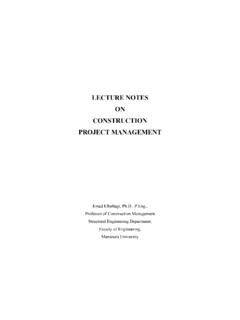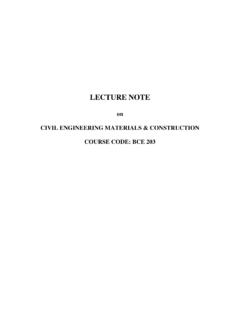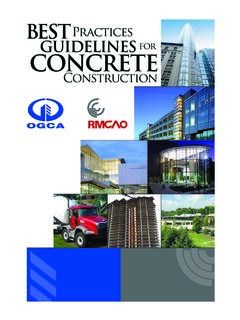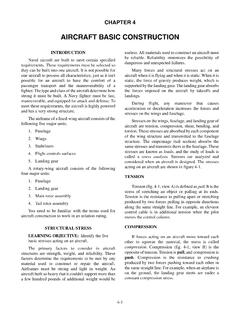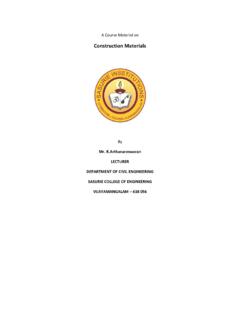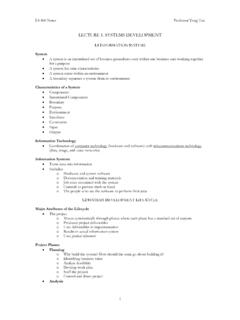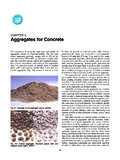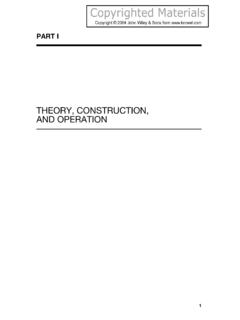Transcription of LECTURE 12 BIOREMEDIATION - MIT OpenCourseWare
1 LECTURE 12 BIOREMEDIATIONB ioremediationBioremediation is the use of microorganisms to destroy or immobilize waste materialsMicroorganisms include:Bacteria (aerobic and anaerobic)FungiActinomycetes (filamentous bacteria) BIOREMEDIATION mechanismMicroorganisms destroy organic contaminants in the course of using the chemicals for their own growth and reproductionOrganic chemicals provide:carbon, source of cell building material electrons, source of energyCells catalyze oxidation of organic chemicals (electron donors), causing transfer of electrons from organic chemicals to some electron acceptorElectron acceptorsElectron acceptors:In aerobic oxidation, acceptor is oxygenIn anaerobic, acceptor is (with decreasing efficiency).
2 NitratemanganeseironsulfateMicroorganism s also need essential nutrients such as nitrogen and phosphoruspE-10-50+5+10+15 AEROBIC RESPIRATIONIRON REDUCTIONSULFATE REDUCTIONNITRATE REDUCTIONMANGANESE REDUCTIONMETHANE FERMENTATIONDENITRIFICATIONI mage adapted from: Wiedemeier, T., J. T. Wilson, D. H. Kampbell, R. N. Miller, and J. E. Hansen, 1995. Technical Protocol for Implementing Intrinsic Remediationwith Long-Term Monitoring for Natural Attenuation of Fuel Contamination in Groundwater. Air Force Center for Environmental Excellence, San Antonio, Texas. November 11, 1995.
3 Figure , Pg. growthTypically very rapid if food (carbon source) is present: population doubles every 45 minutesPristine soils contain 100 to 1000 aerobic bacteria per gram of soilIncreases to 105within one week if carbon source is introducedLimitations to biodegradation Adequate bacterial concentrations (although populations generally increase if there is food present) Electron acceptors Nutrients ( , nitrogen and phosphorus) Non-toxic conditions (NAPL pools are likely to be toxic) Minimum carbon source (which may exceed regulatory limits for toxic chemicals)
4 Note that rapid growth may be limited by diffusive or advective transport of any of the aboveHistory of bioremediation1972 - First commercial application: Sun Oil pipeline spill in Ambler, Pennsylvania1970s - Continuing BIOREMEDIATION projects by Richard Raymond of Sun Oilmid-1980s - emphasis on bioengineering organisms for BIOREMEDIATION . This technology did not live up to its initial promise1990s - emphasis switched to greater reliance on natural microorganisms and techniques to enhance their performanceRelative biodegradabilitySimple hydrocarbons and petroleum fuelsdegradability decreases as molecular weight and degree of branching increaseAromatic hydrocarbonsone or two ring compounds degrade readily, higher molecular weight compounds less readilyAlcohols.
5 EstersNitrobenzenes and ethers degrade slowlyChlorinated hydrocarbonsdecreasing degradability within increasing chlorine substitution highly chlorinated compounds like PCBs and chlorinated solvents do not appreciably degrade aerobicallyPesticides are not readily degradedIncreasing biodegradabilityBioremediation technologies for soilComposting addition of moisture and nutrients, regular mixing for aerationBiopiles ex-situaeration of soilBioventing in-situaeration of soilLand treatment application of organic materials to natural soils followed by irrigation and tillingCompostingSource: , 2000.
6 Windrow Composting of Explosives-Contaminated Soil. Army Environmental Center. ( )Composting is a process by which organic wastes are degraded by microorganisms, typically at elevated temperatures. Typical compost temperatures are in the range of 55 to 65 Celsius. The increased temperatures result from heat produced by microorganisms during the degradation of the organic material in the waste. Windrow composting has been demonstrated using the following basic steps. First, contaminated soils are excavated and screened to remove large rocks and debris.
7 The soil is transported to a composting pad with a temporary structure to provide containmentand protection from weather extremes. Amendments (straw, alfalfa, manure, agricultural wastes and wood chips) are used for bulking agents and as a supplemental carbon source. Soil and amendments are layered into long piles, known as windrows. The windrow is thoroughly mixed by turning with a commercially available windrow turning machine. Moisture, pH, temperature, and explosives concentration are monitored. At the completion of the composting period the windrows would be disassembled and the compost is taken to the final disposal area.
8 PROCESS PERFORMANCEW indrow composting has been demonstrated as an effective technology for treatment of explosives-contaminated soil. During a field demonstration conducted by USAEC at UMDA, TNT reductions were as high as at 30% soil in 40 days of operation, with the majority of removal occurring in the first 20 days of operation. Maximum removal efficiencies for RDX and HMX were image at the Web site of Resource Recovery Systems of Nebraska, Inc., KV Compost Equipment, Windrow Composting. May 11, : USAEC, 2000. Biopilesof POL Contaminated Soils.
9 Army Engineer Environmental Center. ( )Biopile treatment is a full-scale technology in which excavated soils are mixed with soil amendments, placed on a treatment area, and bioremediated using forced aeration. The contaminants are reduced to carbon dioxide and water. Developed by the Naval Facilities Engineering Service Center, the basic biopile system includes a treatment bed, an aeration system, an irrigation/nutrient system and a leachate collection system. Moisture, heat, nutrients, oxygen, and pH are controlled to enhance biodegradation. The irrigation/nutrient system is buried under the soil to pass air and nutrients either by vacuum or positive pressure.
10 Soil piles can be up to 20 feet high and may be covered with plastic to control runoff, evaporation and volatilization, and to promote solar heating. If volatile organic compounds (VOCs) in the soil volatilize into the air stream, the air leaving the soil may be treated to remove or destroy the VOCs before they are discharged into the atmosphere. Treatment time is typically 3 to 6 : Environmental Protection Agency, Tech Trends newsletter, June 2001. Accessed May 11, 2004. Researchers at the University of North Dakota s Energy & Environmental Research Center began studying related site-specific issues and remediation options for soil contaminated with amines, amine byproducts, and salts at a decommissioned gas plant near Calgary, Alberta.










